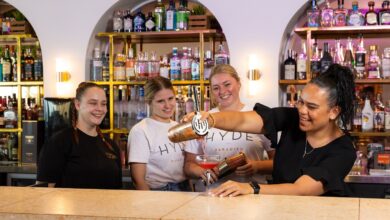
Australia’s tourism and hotel industries have finally begun their long journey toward recovery, but the forecast is rocky according to the latest Deloitte tourism and hotel market outlook.
In her report, Deloitte Access Economics partner and Deloitte national tourism leader, Adele Labine-Romain, says while Australia achieved so much in combatting the pandemic, success on the health and economic fronts has placed a heavy burden on tourism and the hotel sector.
“They were the first to be impacted by government public health COVID responses, they will still be among the last to recover, and that recovery remains highly uncertain and reliant on many factors, from local and international economic developments and COVID’s ongoing unpredictability,” Ms Labine-Romain said.
“With travel restrictions gradually easing for most parts of the country, and the lifting of our international travel ban, the recovery can hopefully gain traction, but the industry will remain under pressure until borders are fully open again and the relatively free flow of people into, and within, Australia can resume.”
Ms Labine-Romain said while tourism had been “shattered” as states and territories shut their borders to non-essential trips in March 2020, there were then early signs of recovery from the September 2020 quarter, as restrictions began to ease in some states, albeit more in the leisure than business segment.
This, she said, continued through to most of the June 2021 quarter before the start of Delta-induced lockdowns and border closures which again stopped the domestic tourism recovery almost in its tracks.
“Globally, a significant share of consumers is still not ready to head overseas. Other than India, less than 30 percent of consumers across Australia’s key source markets are showing a likelihood to travel internationally for leisure purposes, an indication that the effects of the pandemic on global tourism will take some time to unwind, and a slower recovery for our inbound, and export dollar generating, travel industry,” she said.
And Ms Labine-Romain’s outlook?
“It’s fair to say Australians are desperate to travel, especially heading into the traditional peak holiday season, and well into 2022,” she said.
“There is increasing hope for Australian tourism’s recovery given our relatively high vaccination rates and state and territory re-opening plans.
“However, authorities have put the brakes on reopening once again, with planned travel bubbles with Korea and Japan, and the return of international students, now pushed back to 15 December to allow for more time to learn about the new variant.
“Some market segments are expected to recover more quickly than others, led by the holiday segment and those looking to reconnect with friends and family, and initially from short haul source markets in the region.
“Virtual meeting technologies, cost savings and organisations’ growing consciousness around sustainability will see corporate travel face a slower return than leisure travel.
“Overnight trips in Australia are forecast to grow to 94 million by the end of 2021, down on earlier forecasts thanks to Delta setbacks, and expected to surpass 2019 levels and reach 124 million trips by the end of 2022, and 132 million trips by 2023.
“The recovery of international tourism is going to be slower than expected, and than the industry would like. While arrivals are forecast to reach around 6.6 million by the end of 2022, 76 percent per cent of 2019 levels, this early recovery stimulated by pent up demand is expected to moderate after 2022, and only return to 2019 levels in 2025.
“To offset the shortfall in international visitor spend, any increase in domestic travel by Australians needs to be above already high levels of domestic tourism activity.
“It would take around seven domestic overnight trips to generate the equivalent spend of one international visitor. And this would need to be in addition to the average 14 domestic trips Australians typically take in a year. This represents a significant challenge for policy settings and the sector.”
Ms Labine-Romain said Delta lockdowns in Sydney and Melbourne have devastated hotel markets in those cities, pulling occupancy rates down to the 20 percent range, and placed further pressure on smaller markets such as Adelaide, Canberra, Darwin and Hobart dependent on interstate travel demand.
That said, she said, state and territory government incentive schemes to encourage intrastate and territory travel were warmly welcomed by the sector and had a strong and positive impact on occupancy rates.
“A number of hotel projects in development in the years preceding the pandemic saw around 3,700 new rooms added to the market in 2021,” Ms Labine-Romain said.
“In Melbourne, new brands included the W Hotel, which opened in early 2021 and the Hyatt Centric, which came on line in December. The Marriott’s The Tasman opened in Hobart, and Sofitel made its debut in Adelaide.
“Looking ahead, there is the potential for around 15,000 new rooms in likelihood adjusted terms to be added to the room stock across the country in coming years, with around 5,000 of these expected to open in 2022.
“These are significant numbers, especially so in some markets with 60 percent of the new stock concentrated in Melbourne, Gold Coast and Sydney. The pipeline is weaker than our outlook earlier in the year, due to a shift of some developments from hotel to residential, and delays in commitment from investors of projects not yet in final stages of planning or construction.
“The pace of recovery for hotels will vary across the city markets. Brisbane, Perth, Gold Coast, Canberra and Darwin are expected to see occupancy rates return to 2019 levels by 2023. Sydney and Melbourne will take a little longer due to their high pre-pandemic occupancy rates, their greater dependence on demand from international tourists and corporate travellers, and significant new supply coming on line.
“Average room rates are expected to recover more quickly than occupancy, returning to 2019 levels ($194) by the end of 2022 for all markets, given properties mostly maintained rates even in periods where demand was restricted.”

AccomNews is not affiliated with any government agency, body or political party. We are an independently owned, family-operated magazine.







